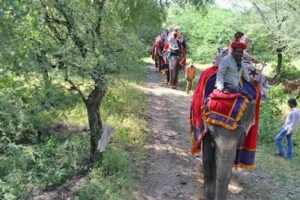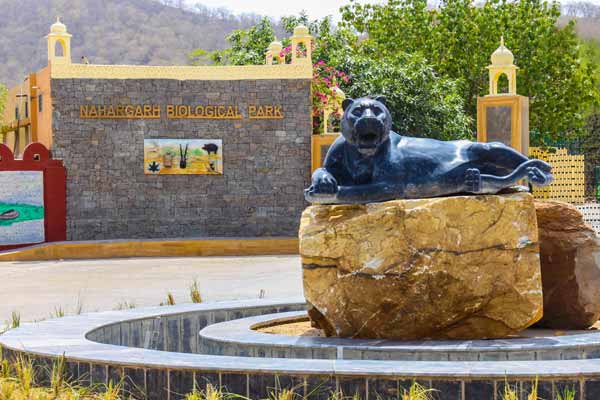Introduction
In the heart of the princely state of Rajasthan, where history and nature converge, lies Nahargarh Biological Park—an ecological haven that unfolds a tapestry of wilderness against the backdrop of the majestic Aravalli Range. Located on the outskirts of Jaipur, the Pink City, Nahargarh Biological Park stands as a testament to the region’s commitment to wildlife conservation, biodiversity, and sustainable tourism. As visitors venture into this natural sanctuary, they find themselves immersed in a realm where flora and fauna flourish, offering a unique and enriching experience.


Historical Roots
Nahargarh Biological Park is an extension of the historic Nahargarh Fort, perched on the Aravalli hills. The fort, built in the 18th century by Maharaja Sawai Jai Singh II, served as a defensive bastion for the city of Jaipur. Today, the fort’s legacy endures in the form of this biological park, which was inaugurated in 2016 with the aim of preserving the region’s rich biodiversity and creating an eco-friendly space for both wildlife and visitors.
The park derives its name from Nahargarh, which means “Abode of Tigers.” The fort and its surroundings were once inhabited by tigers, leopards, and other wildlife. The creation of Nahargarh Biological Park represents a conservation initiative to reintroduce native species and create a sustainable habitat for the region’s diverse flora and fauna.
Flora and Fauna Diversity
Nahargarh Biological Park unfolds over an expansive area, creating a mosaic of ecosystems that support a wide array of plant and animal life. The park is home to over 285 species of plants, including native trees, shrubs, and medicinal herbs, which contribute to the conservation of the region’s unique vegetation.
As visitors explore the park’s winding trails, they encounter a diverse range of wildlife. From the majestic Indian leopard and graceful sambar deer to the playful langurs and elusive Indian striped hyena, Nahargarh Biological Park provides a sanctuary for the native species of the Aravalli hills. The park’s avian population is equally impressive, with over 150 species of birds, including migratory visitors during the winter months.
Zones and Exhibits
The park is divided into distinct zones, each designed to replicate the natural habitats of the region’s wildlife. The Leopard Zone, for instance, provides a spacious and secure environment for the Indian leopards, allowing visitors to observe these majestic creatures in a setting that mirrors their natural surroundings.
The Herbivore Zone is home to various deer species, including the spotted deer and sambar deer. Here, visitors can witness the grace and beauty of these herbivores as they roam freely in an environment that simulates their natural habitat.
The Lion Safari, another highlight of the park, offers a unique experience for visitors to observe lions in an expansive enclosure that closely resembles their natural territory. The safari is designed to prioritize the well-being and conservation of these magnificent animals.
Conservation and Education
Beyond its role as a tourist destination, Nahargarh Biological Park is actively involved in conservation efforts and environmental education. The park collaborates with wildlife experts, researchers, and conservationists to implement breeding programs for endangered species and to monitor the overall health of the ecosystem.
Educational programs and guided tours are conducted to raise awareness about wildlife conservation, the importance of biodiversity, and the delicate balance of ecosystems. The park serves as an outdoor classroom, where visitors, especially students, can learn about the region’s flora and fauna while gaining a deeper understanding of the significance of preserving natural habitats.
Adventure and Eco-Tourism
Nahargarh Biological Park is not just a passive observation space; it’s a hub for adventure enthusiasts and eco-tourists. The park offers trekking trails that wind through the Aravalli hills, providing panoramic views of the surrounding landscape. These trails offer a unique blend of natural beauty, historical remnants, and the thrill of spotting wildlife in their natural habitat.
For those seeking a more relaxed experience, the park has designated picnic areas where visitors can unwind and enjoy the serene atmosphere. The park’s facilities also include eco-friendly cottages and camping sites, allowing visitors to immerse themselves in the tranquility of nature without compromising on comfort.
Panoramic Views and Sunset Points
One of the most enchanting aspects of Nahargarh Biological Park is its vantage points that offer breathtaking panoramic views of the surrounding landscape. As visitors ascend the hills, they are rewarded with vistas that stretch as far as the eye can see, capturing the essence of Rajasthan’s rugged beauty.
Sunset points within the park provide a magical setting for capturing the changing hues of the sky as the sun dips below the horizon. The play of light on the Aravalli hills, coupled with the tranquil ambiance, creates a serene and picturesque moment that lingers in the memory of those fortunate enough to witness it.
Visitor Facilities and Sustainable Practices
Nahargarh Biological Park is committed to providing a comfortable and sustainable experience for visitors. The park boasts well-maintained pathways, informative signages, and designated resting areas to enhance the overall visitor experience. Eco-friendly practices, such as waste management and water conservation, are integral to the park’s operational ethos.
The park also houses a visitor center that provides information about the flora and fauna, conservation initiatives, and guidelines for responsible tourism. Workshops and interactive sessions are organized to engage visitors in the conservation dialogue, fostering a sense of responsibility and stewardship toward the environment.
Community Engagement and Local Impact
Recognizing the symbiotic relationship between wildlife conservation and community welfare, Nahargarh Biological Park actively engages with local communities. The park supports livelihood initiatives, promotes eco-friendly practices among nearby villages, and collaborates with local schools for environmental education programs.
Local artisans and entrepreneurs are encouraged to showcase their products at the park, providing a platform for the region’s cultural heritage to thrive. This collaborative approach ensures that the benefits of tourism extend beyond the park’s boundaries, positively impacting the lives of those living in the vicinity.
Future Vision and Sustainability
Nahargarh Biological Park envisions a future where wildlife conservation, sustainable tourism, and community engagement converge seamlessly. The park’s long-term goals include expanding its conservation efforts, introducing more species to their natural habitats, and further enhancing the eco-tourism experience for visitors.
Sustainability remains at the forefront of the park’s vision, with plans to implement eco-friendly technologies, promote renewable energy sources, and continually assess and reduce the ecological footprint of the park’s operations. As Nahargarh Biological Park evolves, it strives to be a model for wildlife conservation and responsible tourism, setting a precedent for other regions to follow.
Conclusion
Nahargarh Biological Park stands as a beacon of hope for wildlife conservation in the heart of Rajasthan. It invites visitors to embark on a journey that transcends the boundaries of traditional tourism, offering an immersive experience where nature, history, and wildlife converge. As the Aravalli hills cradle this ecological haven, Nahargarh Biological Park emerges not only as a tourist destination but as a sanctuary of sustainability, where the delicate dance of flora and fauna unfolds against the rugged canvas of Rajasthan’s timeless beauty.























